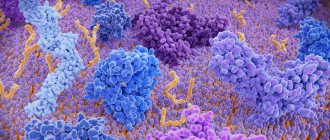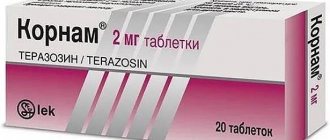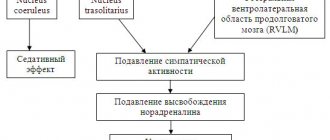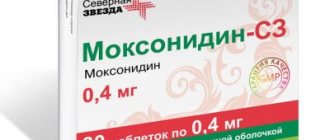pharmachologic effect
Angiotensin II receptor antagonist. Angiotensin II is the main enzyme of the RAAS, which is involved in the pathogenesis of arterial hypertension, heart failure and other cardiovascular diseases.
Candesartan is a selective antagonist of angiotensin II receptors, subtype 1 (AT1 receptors). Does not exhibit agonist properties (does not affect ACE and does not lead to the accumulation of bradykinin or substance P, does not bind to receptors of other hormones, does not affect the state of ion channels involved in the regulation of the cardiovascular system). As a result of blocking the AT1 receptors of angiotensin II, there is a compensatory dose-dependent increase in renin activity, the concentration of angiotensin I, angiotensin II and a decrease in the concentration of aldosterone in the blood plasma.
Arterial hypertension
Oral administration of candesartan provides a dose-dependent, smooth decrease in blood pressure due to a decrease in peripheral vascular resistance without a reflex increase in heart rate. There is no data on the development of severe arterial hypotension after taking the first dose or on the development of withdrawal syndrome after cessation of therapy.
The onset of antihypertensive action after taking the first dose of the drug usually develops within 2 hours, the duration of the effect is 24 hours. With ongoing therapy with candesartan at a fixed dose, the maximum reduction in blood pressure is usually achieved within 4 weeks and persists throughout treatment. The addition of the thiazide diuretic hydrochlorothiazide to candesartan enhances its antihypertensive effect.
The patient's age and gender do not affect the effectiveness of the drug. Candesartan increases renal blood flow and does not change or increases glomerular filtration rate, while renal vascular resistance and filtration fraction are reduced.
Candesartan has a less pronounced antihypertensive effect in patients of the Negroid race (a population with predominantly low renin activity in blood plasma).
There are no data on the effect of candesartan on the progression of diabetic nephropathy. In patients with arterial hypertension and type 2 diabetes mellitus, candesartan does not have a negative effect on blood glucose concentrations and lipid profiles.
Heart failure
Therapy with candesartan reduces the mortality rate and the frequency of hospitalization in patients with chronic heart failure (CHF), regardless of age, gender and concomitant therapy, and leads to a decrease in the functional class of CHF according to the NYHA classification.
Candesartan is effective in patients taking concomitant beta-blockers in combination with ACE inhibitors; Moreover, its effectiveness does not depend on the dose of the ACE inhibitor. In patients with CHF and reduced left ventricular systolic function (left ventricular ejection fraction (LVEF) less than 40%), candesartan reduces peripheral vascular resistance and wedge pressure in the pulmonary capillaries.
Pharmacokinetics
Suction and distribution
Candesartan cilexetil is a prodrug. Candesartan cilexetil after oral administration is quickly converted into the active substance - candesartan, through ether hydrolysis. When absorbed from the digestive tract, it binds firmly to AT1 receptors and dissociates slowly, and does not have agonist properties.
The absolute bioavailability of candesartan after oral administration is approximately 40%. Relative bioavailability is approximately 34%. Cmax in blood serum is achieved 3-4 hours after oral administration. Plasma concentration increases linearly with increasing dose in the therapeutic range (up to 32 mg).
The degree of binding to blood plasma proteins is high (more than 99%). Vd of candesartan is 0.13 l/kg. Does not accumulate. The pharmacokinetic parameters of candesartan do not depend on the patient’s age, gender or meal time.
Metabolism and excretion
Candesartan is mainly excreted unchanged from the body by the kidneys and intestines. Slightly metabolized in the liver (20-30%) with the participation of CYP2C9 with the formation of an inactive derivative.
T1/2 of candesartan is approximately 9 hours. The total clearance is about 0.37 ml/min/kg, while the renal clearance of the drug is 0.19 ml/min/kg. After oral administration of 14C-labeled candesartan cilexetil, 26% of the dose was excreted by the kidneys in the form of candesartan and 7% in the form of an inactive metabolite, while 56% of the dose was excreted through the intestines with bile in the form of candesartan and 10% in the form of an inactive metabolite. After a single oral dose, more than 90% of the dose is eliminated within 72 hours.
Pharmacokinetics in special groups of patients
In elderly patients (over 65 years of age), the Cmax and AUC of candesartan increase compared to young patients by approximately 50% and 80%, respectively. However, the blood pressure response and possible side effects when using candesartan do not depend on the age of the patients.
In patients with mild or moderate renal impairment, the Cmax and AUC of candesartan increase by approximately 50% and 70%, respectively, while T1/2 does not change compared to patients with preserved renal function. Pharmacokinetics in patients on hemodialysis are similar to those in patients with severe renal impairment. In patients with severely impaired renal function, Cmax and AUC increase by 50% and 110%, respectively, and T1/2 of the drug increases by 2 times.
In patients with mild or moderate hepatic impairment, the mean AUC of candesartan increased by approximately 20% in one study and 80% in another study. There is no experience of use in patients with severe liver dysfunction.
What does Perindopril help with?
Tablets 2 mg, 4 mg and 8 mg, including those with indapamide, amlodipine. Perindopril instructions for use belong to the group of ACE inhibitors. The medicine is prescribed to patients with various heart diseases and arterial hypertension. At what pressure to take this medicine, you can find out from the reviews of cardiologists. What does Perindopril help with? Indications for use are narrow-profile for a therapeutic hospital due to the specificity of the therapeutic effect of Perindopril tablets:
- prevention of recurrent stroke or stroke after transient ischemic attack;
- stable coronary heart disease;
- arterial hypertension;
- hypertension of renovascular etiology;
- chronic heart failure.
Perindopril is available in the form of tablets intended for oral use. The tablets are packaged in blisters of 30 pieces per package; detailed instructions with a description are attached to the drug. Each tablet contains the active ingredient - Perindopril 4 mg or 8 mg, as well as a number of additional excipients, including lactose monohydrate, which should be reported to patients with congenital intolerance to this component.
Contraindications for use
- Hypersensitivity to candesartan or other components of the drug;
- lactose intolerance, lactase deficiency, glucose-galactose malabsorption syndrome;
- pregnancy;
- breastfeeding period;
- children and adolescents under 18 years of age (efficacy and safety have not been established);
- severe liver dysfunction and/or cholestasis;
- simultaneous use with aliskiren and aliskiren-containing drugs in patients with diabetes mellitus or impaired renal function (GFR less than 60 ml/min).
With caution: severe renal dysfunction (creatinine clearance less than 30 ml/min), hemodialysis, bilateral renal artery stenosis or stenosis of the artery of a single kidney, hemodynamically significant stenosis of the aortic and/or mitral valve, hypertrophic obstructive cardiomyopathy (HOCM), condition after kidney transplantation, cerebrovascular disorders of ischemic origin and ischemic heart disease, hyperkalemia in patients with reduced blood volume, general anesthesia and surgical interventions (risk of developing arterial hypotension due to blockade of the RAAS), primary hyperaldosteronism.
Use during pregnancy and children
The drug Giposart is contraindicated for use during pregnancy, because it has a direct effect on the RAAS and can cause developmental disorders of the fetus (especially in the second and third trimesters of pregnancy) or have a negative effect on the newborn, including death, if the drug was used during pregnancy.
It is known that therapy with angiotensin II receptor antagonists (ARA II) can cause fetal developmental disorders (impaired renal function, oligohydramnios, delayed ossification of the skull bones) and the development of complications in the newborn (renal failure, arterial hypotension, hyperkalemia). If the fact of pregnancy is established, the drug Giposart must be discontinued as quickly as possible.
When planning pregnancy, it is necessary to transfer the patient to adequate alternative therapy.
It is not known whether candesartan is excreted in breast milk, but it is known to be excreted in the milk of lactating rats.
During treatment with Hyposart, breastfeeding should be stopped. Newborns whose mothers took Hyposart during pregnancy should be under close medical supervision due to the likelihood of developing arterial hypotension.
Use in children
The use of the drug is contraindicated in children and adolescents under 18 years of age (efficacy and safety have not been established).
Side effects
Classification of the frequency of side effects: very often (≥1/10); often (≥1/100, <1/10); uncommon (≥1/1000, <1/100); rare (≥1/10,000, <1/1000); very rare (<1/10,000), including isolated reports.
Side effects of candesartan are mild and transient. The frequency of side effects does not depend on the dose of the drug and the age of the patient.
From the nervous system: often - dizziness, headache, weakness.
From the cardiovascular system: often - a pronounced decrease in blood pressure.
From the respiratory system: often - respiratory infections, pharyngitis, rhinitis, cough.
From the digestive system: very rarely - nausea, increased activity of liver transaminases, impaired liver function or hepatitis.
From the urinary system: often - impaired renal function, including renal failure in predisposed patients.
From the musculoskeletal system: very rarely - back pain, arthralgia, myalgia.
From the hematopoietic system: very rarely - leukopenia, neutropenia, thrombocytopenia and agranulocytosis.
Laboratory indicators: very rarely - hyperkalemia, hyponatremia, increased creatinine concentration in the blood, hyperuricemia, slight decrease in hemoglobin.
Allergic reactions: very rarely - angioedema, skin rash, itching, urticaria.
Other: exacerbation of gout, “flushes” of blood to the skin of the face.
Perindopril: analogues and substitutes
Instead of this main remedy, patients in some cases can use substitutes such as:
- Lisinopril.
Cheap, long-acting ACE inhibitor. The active ingredient is lisinopril. Indications for use are no different. An additional advantage is that the drug is not metabolized in adipose tissue, which, in turn, allows its use by overweight patients. - Diraton.
A fairly cheap ACE inhibitor containing 2.5 mg of lisinopril as the initial active ingredient (in the form of lisinopril dihydrate). Reduces the breakdown of bradykinin and the release of aldosterone, increases the synthesis of prostaglandins. Unlike perindopril, it has lower and at the same time variable bioavailability. In addition, more time passes before the effect occurs. - Parnavel.
A fairly affordable analogue containing 4 mg of perindopril. Being an antihypertensive and cardioprotective agent, a vasodilator, its indications include arterial hypertension (including renovascular, that is, caused by narrowing of the renal arteries) and chronic heart failure. - Captopril.
One of the most affordable analogues of Perindopril on the market. The original substance is captopril. A very cheap drug in tablet form, available in dosages of 25 and 50 mg. The range of indications, like all ACEs, ranges from arterial hypertension and heart failure to diabetic nephropathy. In addition, it is used for impaired left ventricular function after myocardial infarction.
Perineva and Perindopril, what is the difference?
Perineva is a domestic drug for stabilizing blood pressure. Available in two dosages - 4 and 8 mg. Prescribed by a doctor and available with a prescription. With prolonged use, undesirable reactions are possible, such as cough and bronchospasm. The price of the medication depends on the dosage and number of tablets (30 or 90 pieces) and ranges from 250 to 1200 rubles. In case of intolerance to the active substance, inability to purchase it due to high cost or defectiveness, ineffectiveness and other factors, the issue of selecting analogues of the drug Perineva is relevant.
The choice of substitutes should be agreed with your doctor - they are available by prescription and have prescription restrictions and side effects.
Perindopril is a cheap Russian analogue of Perineva, available in dosages of 4 and 8 mg. Produced by the following domestic companies: Biokhimik, Pranafarm, Izvarino, Severnaya Zvezda. The price is lower than Prestarium and Perineva. Side effects occur more often. The properties and composition of Perineva and the analogue Perindopril are identical: they contain perindopril, which turns into the active metabolite perindoprilat. Medicines are cumulative, stabilize blood pressure, improve quality of life and reduce the risk of complications from coronary artery disease, heart attack and stroke. When choosing between analogues, it is advisable to give preference to trusted manufacturing companies and consult a cardiologist.
Perindopril or Prestarium, which is better?
Indications for the use of medications are identical. The main ones:
- Treatment of arterial hypertension.
- Chronic heart failure.
- Stable coronary heart disease.
- Reducing the likelihood of developing cardiovascular pathologies.
“Perindopril” and “Prestarium” should not be used by women during pregnancy and breastfeeding, is prohibited for children, and is also not recommended if the body is prone to angioedema. The principle of operation of the drugs is the same, but the elimination of Prestarium is carried out with the participation of the kidneys, so the effect may slow down when taken by older people. You can use Prestarium in combination with other drugs, but also separately or for the prevention of heart disease or to reduce blood pressure. "Perindopril" is an analogue of "Prestarium" (the difference is in cost). It belongs to another group of drugs - ACE blockers. It is effectively used to prevent cardiovascular pathologies in patients suffering from ischemia.
There is also an important effect - the analogue is able to reduce afterload on the myocardium of the left ventricle of the heart. The drug is approved for use in people with type I and type II diabetes for high blood pressure. Medicines are interchangeable (the dosage is the same). It is usually recommended to take one tablet in the morning (the duration of the effect of the drug reaches 24 hours). To achieve a positive result, it is necessary to use these medications systematically, strictly in the sequence and dosage as prescribed by the doctor.
Lisinopril or Perindopril, which is better?
Lisinopril and Perindopril are the two most popular antihypertensive drugs. They have different active substances, but both belong to the group of ACE inhibitors. The main indication for use is the elimination of sudden jumps and persistently high blood pressure (BP). However, research shows that they also improve the length and quality of life of patients with cardiovascular diseases.
Despite the different compositions, the pronounced hypotensive effect of these drugs is achieved due to one principle of action, which involves performing the following tasks:
- Suppression of ACE synthesis, which contributes to the expansion of the vascular bed.
- Normalizes the rate of blood circulation and reduces the load on the heart muscle.
- Increasing the elasticity of arterial vessels.
- Removing excess collagen.
- A decrease in peripheral resistance to blood flow, which is accompanied by a decrease in the load on the myocardium.
- Increasing the endurance of the heart muscle to changes in blood pressure during exercise.
The bioavailability of both drugs is 25%, and both of them are not prodrugs and are not metabolized in the liver. The treatment regimen is the same, however, the number of tablets taken is different due to different compositions and dosages. Absolute and relative contraindications are also identical. Common indications for therapy are hypertension and heart failure.
Drug interactions
The use of candesartan concomitantly with drugs containing aliskiren is contraindicated in patients with diabetes mellitus or moderate to severe renal failure (GFR <60 ml/min/1.73 m2).
The simultaneous use of candesartan with hydrochlorothiazide, warfarin, digoxin, oral contraceptives (ethinyl estradiol/levonorgestrel), glibenclamide, nifedipine and enalapril has been studied; no clinically significant pharmacokinetic interaction was observed.
Candesartan is slightly metabolized in the liver (via the CYP2C9 isoenzyme). There was no effect on the CYP2C9 and CYP3A4 isoenzymes; the effect on other cytochrome P450 isoenzymes is currently unknown.
Antihypertensive drugs potentiate the antihypertensive effect of candesartan. Experience with the use of other drugs acting on the RAAS shows that the simultaneous use of the drug and potassium-sparing diuretics (spironolactone, eplerenone, triamterene, amiloride), potassium preparations, salt substitutes containing potassium, or other drugs that can increase the concentration of potassium in the blood serum ( for example, heparin) can lead to the development of hyperkalemia.
With the simultaneous use of lithium preparations and ACE inhibitors, cases of transient increases in the concentration of lithium in the blood serum and the development of toxic effects have been observed. A similar effect is possible with the simultaneous use of lithium drugs and angiotensin II receptor antagonists, which requires periodic monitoring of the concentration of lithium in the blood serum during the combined use of these drugs.
With simultaneous use of ARA II and NSAIDs, including selective COX-2 inhibitors and non-selective NSAIDs (for example, acetylsalicylic acid at a dose of more than 3 g / day), the antihypertensive effect of candesartan may be reduced.
Double blockade of the RAAS
As with ACE inhibitors, simultaneous use of ARB II and NSAIDs increases the risk of decreased renal function, including the development of renal failure, which leads to hyperkalemia in patients with impaired renal function. This combination should be used with caution, especially in elderly patients. All patients should receive sufficient fluids; it is necessary to monitor renal function at the beginning of therapy and thereafter.
The danger of hypertension
Arterial hypertension causes diseases:
- hypertrophy (excessive enlargement) of the ventricles of the heart;
- damage to blood vessels of the fundus and brain;
- diabetes mellitus, kidney diseases, pancreatitis;
- sexual dysfunctions
As a result of hypertension, the heart works harder to overcome the increased resistance of stiff blood vessels. Therefore, left ventricular hypertrophy develops and diastolic relaxation of the myocardium is disrupted, its blood supply deteriorates, arrhythmias and long-term hypertension occur.
If even one artery is blocked, blood transport to part of the heart muscle will stop, which leads to the development of myocardial infarction. If its nutrition is disrupted, angina pectoris develops. High blood pressure also negatively affects the kidneys, which are involved in regulating blood pressure.
Gradually, the blood supply to the kidneys deteriorates, their functions are disrupted: damaged tiny vessels inside the organ reduce its filtering ability. Therefore, sand and stones accumulate in the kidneys and urine (bladder). When waste products are removed abnormally, they enter the bloodstream. Therefore, patients require periodic dialysis and blood purification. Kidney failure occurs when hypertension occurs against the background of diabetes mellitus. If left untreated, the lumen of blood vessels narrows, blood supply and transportation of fresh oxygen to the brain deteriorate. Therefore, disculatory encephalopathy and stroke develop.
Dosage
The drug is taken orally, 1 time/day, regardless of the time of meal.
Arterial hypertension
The recommended initial and maintenance dose of Giposart is 8 mg 1 time / day. If necessary, the dose can be increased to 16 mg 1 time / day. The maximum antihypertensive effect is achieved within 4 weeks of therapy. The maximum daily dose is 32 mg 1 time/day.
If adequate blood pressure control is not achieved at the maximum daily dose, it is recommended to add a thiazide diuretic (eg, hydrochlorothiazide) to therapy. This may enhance the antihypertensive effect of Giposart.
In patients at risk of developing arterial hypotension (including patients with reduced blood volume), it is recommended to start therapy with a dose of 4 mg.
In patients with mild to moderate renal impairment (creatinine clearance 30-80 ml/min/1.73 m2), including patients on hemodialysis, the initial dose of the drug is 4 mg. The dose should be titrated depending on the therapeutic effect. Clinical experience with the use of the drug in patients with severe renal impairment or end-stage renal failure (creatinine clearance less than 15 ml/min) is limited.
The initial daily dose of the drug in patients with mild to moderate liver disease is 4 mg. It is possible to increase the dose if necessary. There is no clinical experience with the use of the drug in patients with severe liver dysfunction and/or cholestasis.
Chronic heart failure
The recommended initial dose of Giposart is 4 mg 1 time / day. An increase to a maximum daily dose of 32 mg 1 time / day or to the maximum tolerated dose is carried out by doubling the dose with an interval of at least 2 weeks.
Elderly patients and patients with impaired renal or liver function do not require adjustment of the initial dose of the drug.
The safety and effectiveness of the drug Giposart in children and adolescents under 18 years of age have not been established.
Concomitant therapy
The drug Giposart can be used simultaneously with other drugs for the treatment of CHF, including ACE inhibitors, beta-blockers, diuretics, cardiac glycosides or combinations of these drugs.
Blood pressure tablets Perindopril
Hypertension is a disease that requires proper and timely treatment. It is characterized by an increase in blood pressure and impairs the oxygen saturation of tissues throughout the body. Due to hypoxia, the functioning of all systems deteriorates, but target organs are especially affected. These include: heart, kidneys, liver and brain. Moreover, it is hypertension that most often becomes the cause of such deadly situations as heart attack, stroke, hypertensive crisis, etc. Therefore, it is very important to normalize the readings on the tonometer in a timely manner.
To lower blood pressure, there is a fairly large list of drugs with different principles of action. At the same time, ACE blockers are considered very effective. They prevent the conversion of angiotensin-1 to angiotensin-2, thereby promoting vasodilation and some other actions that lead to a decrease in blood pressure. One of the drugs from this group is Perindopril. It not only normalizes the readings on the tonometer, but also helps fight heart failure, and also prevents the occurrence of acute situations.
Perindopril is a drug belonging to the group of ACE inhibitors. It blocks the work of angiotensin converting enzyme and also increases the level of bradykinin, a peptide that dilates blood vessels and thus reduces blood pressure. This drug is primarily an antihypertensive drug. In addition, while taking Perindopril, the load on the heart is reduced. Therefore, this medicine can be used not only to eliminate the main symptom of hypertension - high blood pressure, but also to combat certain heart pathologies and acute situations.
Overdose
Symptoms: excessive decrease in blood pressure, dizziness, tachycardia. Isolated cases of drug overdose (up to 672 mg of candesartan cilexetil) have been described, resulting in the recovery of patients without serious consequences.
Treatment: if there is a pronounced decrease in blood pressure, the patient should be placed in a supine position with his legs raised; further - carry out measures aimed at increasing the volume of blood volume (administration of 0.9% sodium chloride solution intravenously). If necessary, sympathomimetic drugs can be prescribed. It is recommended to carry out symptomatic therapy under the control of vital functions of the body. Hemodialysis is ineffective.







